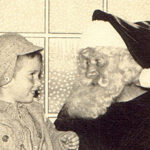Nostalgia, as defined by the American Heritage Dictionary, is “a bittersweet longing for the things, persons, or situations of the past.” If that is the case, then George Saunders’s stories in CivilWarLand in Bad Decline tend to gravitate more toward the bitter than the sweet. The present, as depicted in this collection of stories, whether in the characters’ lives or in society, leaves much to be desired. Everyone is dissatisfied and nostalgic for the past, whether real or imagined. And yet the past, as it is actually remembered, also brings equal discontentment. One might say that Saunders’s characters are simply neurotic to a fault, but a deeper analysis poses a more interesting question about the real source of their unhappiness.
One way in which to examine that source is to look at the way the past is rendered. Throughout his stories, Saunders threads a common theme pertaining to the commodification of nostalgia. For instance, the settings in “Bounty” or the title story, “CivilWarLand in Bad Decline,” take place in theme parks that recreate the past. In “OffLoading Mrs. Schwartz,” the protagonist uses modules to download personal memories to sell to a school principal. In all three stories, the past is treated as entertainment. In “CivilWarLand in Bad Decline,” “The Desperate Patrol,” costumed like soldiers at Gettysburg, enact a rebellion which is suppressed by a “rousing speech,” a sing-a-long, fireworks, and a parade like something out of a Broadway musical (7). The children in “Offloading Mrs. Schwartz,” happily experience sanitized versions of American history via downloaded memories, identifying “a Mercury Cougar with no prompting” and calling each other “Nixon whenever a trust is betrayed” (75). The staged death of a child from cholera in “Bounty” equally becomes a source of amusement when “[t]he Clients titter and check their Events Schedules and a few who are really in the spirit of the thing start laying coins on Scotty’s chest” (90).
Since the past is commodified for entertainment, it is also sanitized or made meaningless for bottom line purposes. Mr. A., the owner of CivilWarLand, cuts corners due to budget crunches. He orders the protagonist to fire Mr. Grayson, the ornithologist hired to keep the bird population in approximation to 1865, due to fiscal restraint and refuses to update the spaceship equipment greeting visitors into the park or use real buffalo meet for the “simulated frontier hunt” (9-11). There are other aspects of this park that have absolutely nothing to do with the Civil War, such as the “Mother Goose Days” (6). The protagonist in “OffLoading Mrs. Schwartz,” censors history to make it more palatable for school children. He does this twice, first with Hank, the elderly robber who breaks into his apartment, and again with Mrs. Schwartz, an elderly woman under his care. He edits out Hank’s hetero- and homosexual “trysts,” profanity, “petty thefts,” and the more brutal realities of war, just as he erases Mrs. Schwartz’s mastectomy, her husband’s mid-life crisis, and her drinking problem (74-75). Considering the fact that both Hank and Mrs. Schwartz no longer own their memories after the narrator downloads them onto his hard drive, his erasing them becomes all the more troubling. These memories are now completely lost.
In these examples, history is made more palatable for a buying public. As Cole, the narrator in “Bounty,” says is BountyLand’s “Statement of Corporate Mission,” the purpose of selling nostalgia is: “To allow the deserving to experience an historical epoch unlike our own in terms of personal comfort” (93). The emphasis, of course, is on the “personal comfort,” since the recreations of the past, whether the Civil War era or the Middle Ages, rarely approximate what people actually experienced during those periods. Another theme that comes up time and again in Saunders’s stories is how the past as it is imagined or manufactured contrasts with how it is experienced. A perfect example of this is in “CivilWarLand in Bad Decline,” with the “ghostly” MacKinnon family. The MacKinnon family is first introduced as a folksy frontier family who once lived on the land on which the park now sits. The Mrs. is seen washing clothes in the nearby creek and is fascinated with machine-stitched clothing. The daughter, Maribeth, reads bad poetry chapbooks and bemoans the lack of an “appropriate boy [who] ever died in the valley” (12). Mr., the family’s patriarch, is a Civil War veteran whose folksy suspicions of modern life masks far more disturbing elements in his character. They are a font of information to the narrator, who appropriates ideas for the park from them, like obscure ballads from the 1800s. There is no indication that the MacKinnon family actually work for the park. They are simply ghostly haunts who roamed the land long before the park had been built on it. This is an important distinction since the MacKinnon family provide a sharp contrast between the history the park portrays and the history the MacKinnon’s represent. It becomes apparent that the MacKinnons are far from the folksy frontier family as they were initially depicted. As it turns out, Mr., shellshocked from the horrors of war, had viciously butchered his family, an act that is “recreated” by the story’s climax. Since the MacKinnons are ghosts, it’s fair to assume that their memories and experiences are authentic. Therefore, the family serve as a reminder that the past, despite its inauthentic representations, can’t be neatly ordered or sanitized.
In that case, the businesses in CivilWarLand in Bad Decline profit from manufacturing the past. What affect, if any, does this have on the characters who work there, who must peddle these artificial histories? Clearly, Saunders’s characters are an unhappy lot. In “CivilWarLand in Bad Decline,” the narrator hates his job and, in the end, is abandoned by his wife and kids, who consider him “irresponsible” and an “oaf” (14). The narrator in “The Wavemaker Falters,” similarly hates his job and his boss, who is sleeping with his wife. He is also wracked with guilt over his responsibility of a child’s death in the pool he operates. The 400-Pound CEO,” is narrated by a character who is mercilessly teased by his coworkers over his weight and, through a series of mishaps, winds up in jail. The lead character in “OffLoading Mrs. Schwartz,” is torn also with guilt and grief, in his case, over his wife’s death, and is dissatisfied with his business. Mary, in “Downtrodden Mary’s Failed Campaign of Terror,” is both frustrated and angry for being dismissed and unwanted at work. In each case, the unhappiness in their lives is traced to their jobs, which in many ways are unsatisfactory and unremunerative. This is clearly shown in the work they are asked to do and their attitudes toward it.
After firing the ornithologist and having to “fend off a few blows,” the narrator in “CivilWarLand in Bad Decline,” states: “Is this the life I envisioned for myself? My God no. I wanted to be a high jumper” (9). When the narrator in “The Wavemaker Falters” rescues a drowning nun, who, in turn, later stabs a cafeteria worker, he can only feel guilt over his good deed. The 400-pound CEO spends his work time doing invoices, lying to clients in letters or phone calls about the fate of the raccoons they’ve captured, or doing errands for his abusive boss, Tim. And while he seems pleased at how well he does his work, he expresses his true feelings through overeating – “When I’ve finished invoicing I enjoy a pecan cluster. Two, actually” (46) and the way he changes the way the business is run once he gains control after Tim’s death, for which he is also responsible. And while Mary enjoys taking care of the Iliana Evermore Fairy Castle, turning off the Maintenance lights, dusting the furniture, picking lint off the “fur items,” etc. (78), she resents being the butt of jokes by visiting school children, being made to pay for a pair of wings which were taken from her by one of the children, having her pay deducted from her while being lectured to by her boss, and cleaning up the vomit in “The Wonder That Is Our Body” exhibit. She takes out her anger by poisoning the see-through cows, not out of any compassion for the cows, but because “I like to make [her boss] sad” (85).
If their jobs are a constant source of irritation and dissatisfaction, then why do they continue to work there? Clearly, they have no choice. The narrator in “CivilWarLand in Bad Decline,” has tried to find other work, but is rejected time and again. “Two hundred send-outs and no nibbles” (4). Mary, perhaps, is too old to find work elsewhere. Her boss eludes to this when he says to visiting Trustee members that he “should insist on an age cut-off, [Mary] is like working with human vegetables” (84). In other words, as Tim’s T-Shirt in “The 400 Pound CEO” implies – “I HOLD YOUR PURSE STRINGS IN MY HOT LITTLE HANDS” (47) – these characters are trapped in their livelihoods.
Since they have no choice but to work in these jobs, their personal lives contradict their workplaces’ demands for cheery representations of life. Like nostalgia, their jobs often mask a deeper truth. Mr. A in “CivilWarLand in Bad Decline,” orders the narrator to keep quiet about Samuel’s increasing homicidal tendencies at the park, telling him to “put this sordid ugliness behind us and get on with the business of providing an enjoyable living for those we love” (19) (italics mine). The 400-pound CEO presents a prettified picture not only about the fate of the raccoons but that of his boss. After he kills Tim, the narrator writes a letter in which [Tim] claims to be going to Mexico to clarify his relationship with God…” (59). Either of these characters must lie in order to keep up the cheery facade their worklife demands. Mary’s personal history contrasts with that of the life the Iliana Evermore Fairy Castle tries to paint. In The Wonder That Is Our Body, an exhibit at the museum, where The Pickled Babies are kept, she is reminded of her own stillborn babies. Our Nation’s Bounty, another exhibit at the Fairy Castle, also contradicts Mary’s memories. When she goes to the exhibit she recollects her own childhood growing up on a farm, when her father “came in smelling of compost…” and “would either beat [Mary and her sisters] or stroke us excessively” (84). While the exhibit features “a barn facade and a few real tractors and a stuffed farmer…,” it hardly resembles a real farm. “…[the see-through cows in the exhibit] have sound enough instincts to know that a functioning scaled-down coal mine with collegiate tour guides in hard harts is not part of any farm” (85) (could the same be said for the visitors who come to the fairy castle museum?). It is interesting to note that a museum dedicated to the biological and mundane functions of life is called the Evermore Fairy Castle, blurring a line between what is genuine and what is not. It is also interesting that Mary works here, since her life has been anything but a fairy tale.
In every story, the reality of these characters’ lives rubs up against the inauthenticity surrounding them. And yet, there is a yearning for that inauthenticity, as well. In “Bounty,” after the narrator escapes from the theme park where he is enslaved, he pines for the days when people drank “Dr. Pepper while driving an Edsel and listening to Muzak on a Victrola” (125). His vision of the past is meant to be humorous, but it is poignantly understandable considering the life he has led. His is a nightmarish, post-apocalyptic world in which Flaweds, like the narrator, are beaten, lynched, or sold into slavery. This character, as well as the others in Saunders’s stories, turn to nostalgia to escape their own present and depressing lives. This is even true for the characters who are aware of the false comfort nostalgia brings. Mary is old enough to know what the past was really like, yet she still recollects fondly about the days when the city where she lived “was made entirely of wood, and men sold goods from carts, and this museum was a floodplain where we all picnicked” (86). She, like Hank and Mrs. Schwartz, have a wealth of “real” knowledge about history, but their knowledge is either undervalued or made irrelevant in a society that is more interested in a past that is increasingly trivialized.
Though the characters long for a nostalgic past, such longing sets them up for doom. In most of Saunders’s stories, his characters who are either nostalgic for the past, such as the narrator in “OffLoading Mrs. Schwartz,” or traffics in the commercialization of nostalgia, are met with more uncertainty and tragedy. The character in “CivilWarLand in Bad Decline,” is murdered. “You know a few things I don’t want broadcast,” his killer, Samuel, says before he is hacked to death. The narrator understands this as well. “Possessing perfect knowledge I hover above him…I see his rough childhood. I see his mother doing something horrid to him with a broomstick. I see hate in his heart and the people he has yet to kill before pneumonia gets him at eighty-three” (26). The narrator in “OffLoading Mrs. Schwartz’ downloads his own memories onto his hard drive, editing out all the sad, painful recollections of his dead wife. Mary, after her one nostalgic reflection of the past after so many unhappy ones, tries to kill herself by jumping off the pier. “I think of how lovely it all could have been had anything gone right, and then I think: Oh heavens, why prolong it, I’ve no income now.” She survives her suicide attempt only because she is unwillingly rescued by Navy boys (87).
In each instance, Saunders’s characters recognize the futility of dwelling in the past, especially one that is ideally manufactured. And yet the present offers no hope for them either. Their lives don’t live up to the cheerful, sanitized versions of the past. Their lives are real, messy, disorderly, full of anger, regret, grief, and sadness. Nostalgia, like the modules in “OffLoading Mrs. Schwartz,” edits out those unpleasant realities, making the past easily digestible for a consuming public. It shouldn’t be surprising then that Saunders’s characters are so unhappy and dissatisfied. Their miserable lives couldn’t possibly live up to those unrealistic standards. Yet all is not hopeless. In the story “Isabelle,” the narrator creates a little life for himself and the title character, finding hope within that misery. “It’s not perfect. Sometimes it’s damn hard. But I look after her and she squeals with delight when I come home, and the sum total of sadness in the world is less than it would have been” (33). He, as well as the narrator in “Bounty,” escape the fate of the other characters in Saunders’s stories, by accepting life as it is, and finding some satisfaction in it by taking control of their own destinies.
Reference:
- CivilWarLand in Bad Decline by George Saunders





